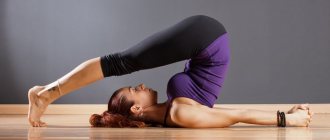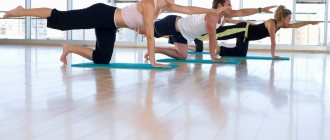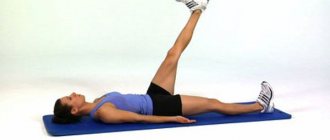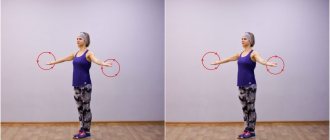Regular yoga practice can greatly improve your flexibility and balance. The first is necessary for the beauty of the body, and the second is for control over it. A beautiful gait, confident movements, the ability to perform any exercise - all this gives a good sense of balance. Balance asanas from our selection will help you develop it.
Top 10 balance asanas for beginners and intermediate levels
This selection of yoga asanas for balance presents poses that will be useful not only for beginners, but also for intermediate levels. Incorporate balance asanas into your regular practice to improve coordination and develop a sense of balance.
Top 25 asanas for the neck and shoulders
Swallow pose on toes
Why: For balance and coordination of movements, calmness and harmony.
How to do it: From a standing position, spread your arms to the sides and take one leg back, lifting it up. Feel stable; to do this, look straight ahead, concentrating on the asana. Stretch your whole body upward, tighten your abs. Rise up onto your toes and remain in this position for as long as possible. Do the same for the other side.
How to make it easier: Do not lift your leg too high or stand on your toes if it is difficult to perform the exercise.
Tree pose
Why: For harmony of mind and body, concentration, awareness, beautiful posture.
How to do it: From a standing position, bend one leg at the knee and place your foot on the thigh of the opposite leg. Raise your arms up, stretching your spine, clasp your palms. Look forward and up, or close your eyes. The body should be elongated, the back may be slightly arched at the lower back. Stretch your whole body upward, as if striving upward, like the crowns of trees. Don't forget to repeat the balance yoga asana on the other leg.
How to make it easier: Place your foot not on your thigh, but on the ankle or shin of the opposite leg.
Dancer pose
Why: For balance and grace, beautiful posture and gait, spontaneity and energy.
How to do it: From a standing position, bend your right leg at the knee, pressing your foot toward your buttocks. Grasp your foot with your right hand and begin to move it back, raising your leg higher and higher. At the same time, extend your left arm forward. In this case, the body moves forward, a slight deflection is formed in the back. Raise your back leg as high as possible, the supporting leg can be slightly bent at the knee. Perform a balance asana on the other side.
How to make it easier: Don't lean too far in your body and don't raise your leg too high. At the initial stage, you can lean on the wall with your free hand.
Straight Leg Extension Pose
Why: For grace and flexibility, harmony and tranquility.
How to do it: From a standing position, lift your right leg forward and move it slightly to the side. With your right hand, grab the foot of your raised leg, trying not to bend your leg at the knee. Extend your left arm to the side for balance. Keep your leg in this position, trying not to move or lean on the wall. Be sure to do a similar balance asana on the other side.
How to simplify: Perform the asana with your hand resting on the wall or raise your bent leg at the knee and grab your hand not by the foot, but by the knee of the raised leg.
Top 20 yoga asanas before bed
Warrior Pose I
Why: For balance and stability, clarity and concentration of the mind, strength and endurance of the body.
How to do it: From a standing position, step your right leg far back and bend your left knee, lowering into a low lunge. Raise your arms up and clasp your palms. The gaze is directed forward and upward. The mind is focused on the asana, the body is tense from the back of the head to the heels. After a few breaths, return to the starting position and repeat for the left leg.
How to Simplify: Keep your hands at your waist or out to your sides for balance to simplify this yoga asana for balance.
Warrior Pose III
Why: For extreme concentration, clarity and harmony of mind, balance, strength and endurance.
How to do it: From a standing position, bend forward with a straight back, while simultaneously moving your right leg back until it is parallel to the floor. Extend your arms straight forward. Shift your body weight to your left leg, it should be stable on the floor. Do not bend your back, try to raise your leg as high as possible. Don't forget to do the balance asana on the other leg.
How to make it easier: Spread your arms out to the sides to make it easier to balance. If it is still difficult, then do not raise your leg too high from the floor, increase the angle gradually.
Half Moon Pose
Why: For balance and coordination, improvement of blood circulation in the pelvic organs, for harmony with oneself.
How to do it: Stand in a high lunge or warrior I pose with your right foot forward. Extend your right arm forward and bend down so that your palm touches the floor. At the same time, lift your left leg off the floor and raise your left arm up. Lean on your right arm and right leg, while looking up towards your left palm. Repeat the yoga balance exercise on the other side.
How to make it easier: If you have a yoga block, then do the crescent pose with your hand resting on it. If there is no block, then perform the exercise against the wall, first leaning on it, and then retreating further and further from it.
Eagle pose
For what: For coordination of movements, balance, self-knowledge and meditation.
How to do it: In a standing position, bend your arms in front of you and place the elbow of your right hand in the cubital fossa of your left. Interlace your palms. Place the thigh of your right leg on the thigh of your left, and place your foot behind your ankle, intertwining your legs. In this position, the left leg will be bent at the knee. Don't round your back, look straight ahead. Do a yoga balance exercise on the other side.
How to simplify: Interlace only the legs one at a time, trying to spend as much time in the pose as possible. When you learn to balance with your legs intertwined, use your arms.
Top 20 abdominal exercises: without crunches and planks
Tiger pose
Why: For balance, coordination of movements, grace and beautiful posture.
How to do it: From a position on all fours, lift your right leg up without straightening it at the knee. Grasp the ankle of your right leg with your left hand, shifting your body weight to the opposite arm and leg. Concentrate on the balance pose, looking forward and down at an imaginary point a few steps away from you. Do the same for the other side.
How to simplify: Do not lift your knee off the floor, remaining on three supports. Gradually raise your leg higher and higher.
Boat pose
Why: To strengthen the abdominal and core muscles, tone the back muscles, balance, harmony of mind and body.
How to do it: Sit on the floor, legs extended forward, back straight. Bend your knees and move your back back 45 degrees. Leaning on your palms, lift your legs bent at the knees up. Straighten your legs, tensing your abs. Lift your hands off the floor and stretch them forward. Your back and legs should be at a 45-degree angle to the floor and to each other.
How to make it easier: Do not straighten your legs when performing the balance asana, keep them bent at the knees until you can hold the pose for at least 40 seconds.
Yoga techniques for balance
Yoga for balance contains a set of special practices. Comprises:
- dynamic exercises;
- static balance asanas;
- breathing practice;
- a kind of meditation.
Balance exercises help balance the internal organs to ensure;
- spine mobility;
- strong immunity;
- open connections;
- confidence in one's strengths and capabilities;
- the ability to see harmony in everything.
Balance asanas are an excellent preventive way to help restore the health of the reproductive and endocrine systems.
There are many exercises that will help you maintain your balance. Even if you just stand on one leg and try to distribute your weight throughout your body, all muscle groups are included in the work, flexibility and stability appear. Today this is the most popular and effective method that can restore spiritual harmony and mental balance.
Top 10 balance asanas for advanced
In the selection of advanced balance asanas you will find poses that require maximum concentration and concentration, but which will give you complete control over your own body. Practice one or two challenging balance poses in addition to your main practice to harmonize your body and mind.
Top 20 leg exercises with dumbbells
Half-sitting pigeon pose
Why: For awareness, calmness of the nervous system, balance and harmony with oneself.
How to do it: Stand straight, bend your right leg at the knee and place its foot on your left thigh. Keep your back straight, arms folded at your chest. While in tree pose, find balance and stability. Then bend your supporting left leg at the knee, lowering yourself into a one-legged squat. In this case, the right leg rests calmly on the left thigh. Go as low as you can, then repeat the balance asana on the other side.
How to make it easier: Don't go into a too deep squat, just bend your knee a little.
Side plank with twine
Why: For strength and endurance, flexibility and balance.
How to do it: Get into plank pose with straight arms, then shift your body weight to your right arm and leg, lifting your left side off the floor. While in a side plank, place your left foot on your right knee. Wrap your left foot in your hand and place your right foot firmly on the floor. Then lift your left leg as high as possible, holding your foot with your hand. Maintain your balance in the balance yoga pose for as long as you can, then do the same on the other side.
How to make it easier: Perform a side plank by bending your top leg at the knee and placing it on the other leg as close to your body as possible.
Single leg split
Why: For flexibility, tone the muscles of the legs and back, balance and concentration.
How to do it: Stand up straight and lift your right leg straight up. Then grab your ankle or foot with your right hand and pull your leg high up until it is parallel to your body. Grab your leg and press it to your body, then freeze, maintaining your balance and not moving. You can clasp your leg not only with one, but also with both hands to bring it as close to the body as possible. Do the same for the other side.
How to make it easier: Perform wall-supported balance asana or do straight leg extension pose instead.
Dancing Dog Pose
Why: For energy, strength and flexibility, as well as to get rid of tension, negativity and stress.
How to do it: Get into a side plank position, supporting yourself on your right arm and leg. Then place your left leg behind your right, and move your left arm far back, arching your back, as if for a bridge. The left arm should be lowered down, and the body should resemble an arch in outline. Look up and fully concentrate on the sensations, because this pose is considered very traumatic for the shoulder joints, it cannot be performed absent-mindedly. Do the same for the other side.
How to simplify: Do not bend too much during balance asana; a small bend is enough at the initial stage.
Single Leg Bridge Pose
Why: To tone the pelvic muscles, beautiful posture, flexibility and strength of the back, harmony with the body.
How to do it: From a lying position, place your arms behind your back and bend them at the elbows, resting on your palms. The fingers should be pointed towards the shoulders. Bend your knees. Straighten your arms while simultaneously lifting your pelvis up. Try to make your body position resemble an arc; to do this, you need to fully straighten your arms and legs. Lock the position and lift one leg up. Stretch your toes as high as possible. Bring your leg back and lift the other one up.
How to simplify: If you do not feel stable in the bridge, then perform a yoga asana for balance without straightening your legs. When you learn to hold the bridge for half a minute, move on to the leg version.
How to stand on the bridge
Crow Pose
Why: For concentration and peace of mind, balance and body control, strengthening the arms and toning the abdominal and core muscles.
How to do it: Lower yourself into a deep squat until your pelvis almost touches the floor. Place your palms on the floor, they should be slightly wider than shoulder-width apart from each other and one step away from your body. Without lifting your palms from the floor, lift your pelvis up while bending your elbows. Rest your knees on your hands and lift your feet off the floor. Transfer your body weight to your arms. Lean forward a little, placing your shins completely on your shoulders. Bend your legs and straighten your elbows, maintaining balance.
How to simplify: Don’t try to rise too high, just lift your feet off the floor and hold the asana for balance for a few seconds. Over time, straighten your arms more and more.
Peacock pose
Why: To normalize all processes in the body, strength, energy and concentration, clarity of mind and control over the body.
How to do it: Sit on your knees and spread them apart. Bring your arms straight together, with your palms facing up. From this position, place your palms on the floor with your fingers facing toward your body. Move your palms as close to you as possible, as if sitting on them. Bend forward to rest your head on the floor, with your stomach resting on your forearms. Resting your stomach on your forearms, transfer your body weight to your arms and lift your head and legs off the floor. Stretch your legs in line with your body. Spread your palms apart if it is difficult to maintain balance.
How to simplify: While performing balance asana, do not lift your head from the floor.
Forearmstand against a wall
Why: For strength, tone of arm and back muscles, balance, improvement of blood circulation, lymph flow and metabolism, control over thoughts and body.
How to do it: Stand with your back to the wall one step away. Sit down and place your palms in front of you. Place your feet against the wall and straighten your back. Then straighten your legs completely, they should be parallel to the floor and at right angles to the body. Lower your forearms to the floor and fix the position.
How to make it easier: Perform a stand with your knees bent.
Scorpio pose
Why: For strength, vigor and concentration, harmonization of internal processes in the body, improvement of blood circulation in the brain, clarity of mind and awareness.
How to do it: Start in dolphin pose (downward-facing dog on your forearms). Transfer your body weight to your forearms, gradually lifting your legs off the floor. When your legs are upright, bend your knees and arch your back. You can also enter the asana from a headstand. To do this, you need to bend your knees and lift your head off the floor, resting only on your forearms.
How to simplify: A complex yoga asana for balance cannot be simplified, but to learn how to perform it, often do stands on your head, hands and forearms against a wall and without support.
Headstand
Why: To relieve tension in the body, relax, improve metabolism, balance and concentration.
How to do it: You can enter a headstand from dolphin pose or from a deep downward bend while standing. In the first option, you need to stand in dolphin pose (downward-facing dog on your forearms) and lean on your head. Step your feet closer to your hands until your back reaches a vertical position. Then lift your feet off the floor, balancing on your forearms and head. Slowly raise your legs until they are in line with your body. In the second option, you need to stand up straight, placing your legs as wide apart as possible. Lean forward with a straight back, leaning on your forearms. Then lower your head and rest the top of your head on the mat between your hands. Raise your legs up while maintaining your balance.
How to simplify: Perform a balance asana against a wall or do a variant with emphasis on one leg.
Eagle Pose (Garudasana)
The pose is named after the mythical half-human, half-bird Garuda. He had enormous power and could increase it. By practicing this asana, you will also notice how the circulation of energy in your body increases.
If shoulder pain occurs, you don’t have to intertwine your hands, but just put one on top of the other
In addition, this pose:
- strengthens the legs and thighs;
- works and improves the mobility of shoulder joints;
- perfectly develops a sense of balance;
- prevents the development of varicose veins;
- saturates the internal organs with blood, increasing the flow to them due to twisting;
- relieves the symptoms of radiculitis.
However, there are a few caveats:
- if you have had knee injuries, then it is better not to practice this pose;
- If you have problems in the lumbar region, you should perform Garudasana with caution.
The technique of the pose is quite simple, but twisting makes it more difficult to maintain balance.
Asana technique
Technique:
- Let's get into Tadasana.
- Bend your knees a little and intertwine your legs. First the left one ends up on top of the right one.
- We hook our left toes onto our right calf.
- Leave the supporting leg bent.
- When we manage to catch balance, we also intertwine our hands: we bend the right one at the elbow at a right angle, we intertwine it with the left one and join our palms.
- We try to stretch out in this position, pushing our elbows slightly upward, as far as the mobility of the shoulder joints allows. The lower abdomen is tightened.
- We stay in this position for 5–10 breathing cycles and slowly unravel first our arms, then our legs.
- You can compensate by bending backwards.
- We return to Tadasana, breathe 2-3 cycles and repeat on the other side.
Video: Eagle Pose
What are the benefits of handstands?
Inverted asana is beneficial for overall health. Hand asanas practiced in yoga contribute to:
- correction of posture;
- pumping up the muscles of the buttocks and abs;
- strengthening arm muscles;
- relieving tension from the spine.
During the execution of the stance, energy flows are distributed throughout the body. Thanks to this, the process of rejuvenation of the body starts. Yogis who regularly practice inverted asanas get rid of negative energy that accumulates in the solar plexus area. A straight stance heats up the energy clot, and it evaporates. Instead of negative energy, the chakras are filled with healing energy from the Cosmos. The intersection of chakra flows distributes it throughout the body.
Extended Leg Pose II (Utthita Hasta Padangusthasana II)
We perform this asana from the previous position; it stretches the muscles of the inner thigh more. Also, performing this pose regularly will help improve the mobility of the hip joints.
Do not rotate your pelvis with your leg
To perform this, you can also use a strap, since in order to abduct the extended leg you need to have a very good stretch.
- We perform Utthita Hasta Padangusthasana I.
- We strengthen this position and, as we exhale, smoothly move our right leg to the right.
- If it is not possible to move it completely to the side, we remain in a comfortable position. The main thing is that the pelvis does not follow the leg, but remains directed forward.
- If you keep your balance comfortably, turn your head in the direction opposite to your foot.
It is worth performing these asanas together, one after another, for symmetrical and comprehensive development.











